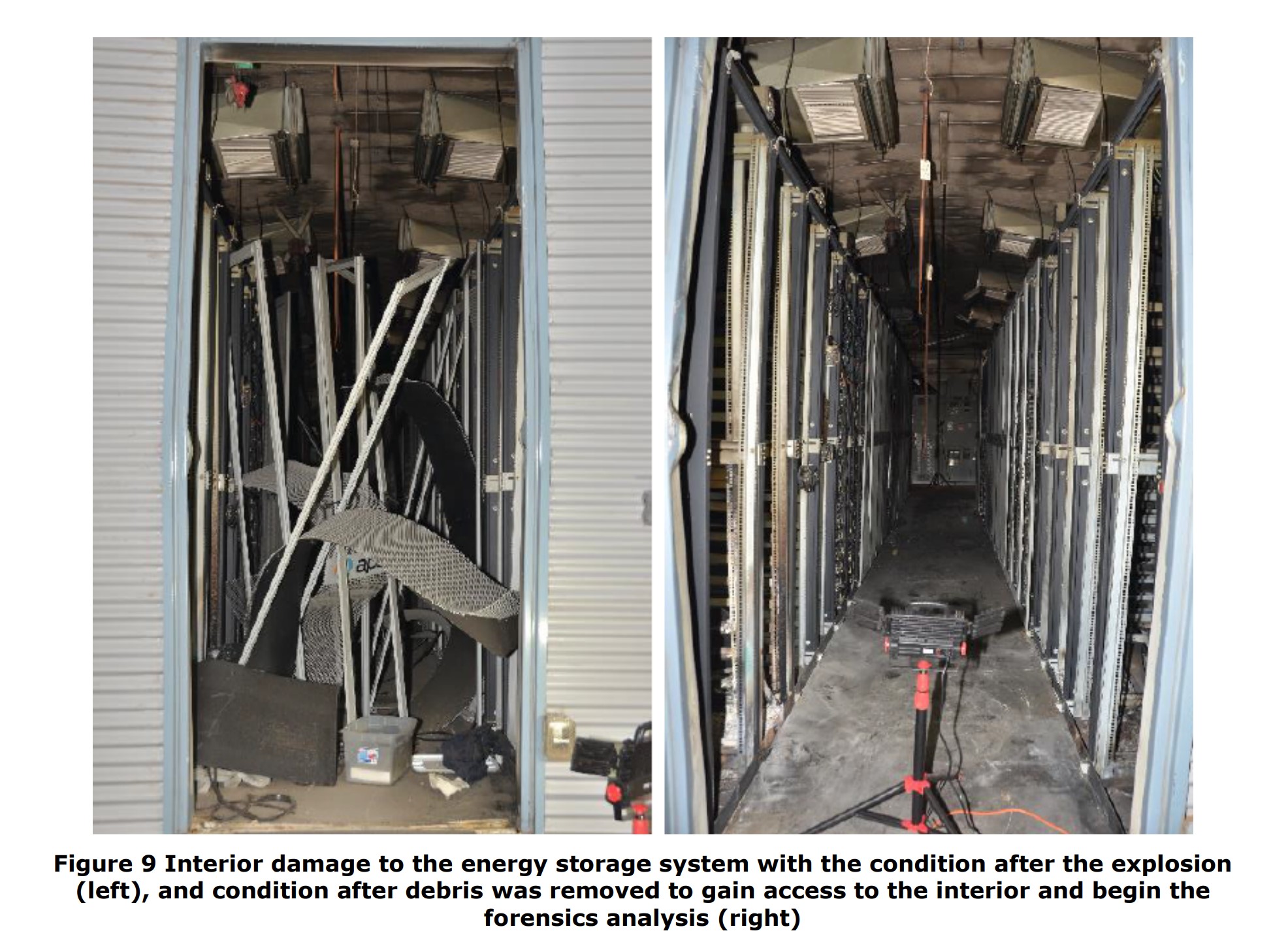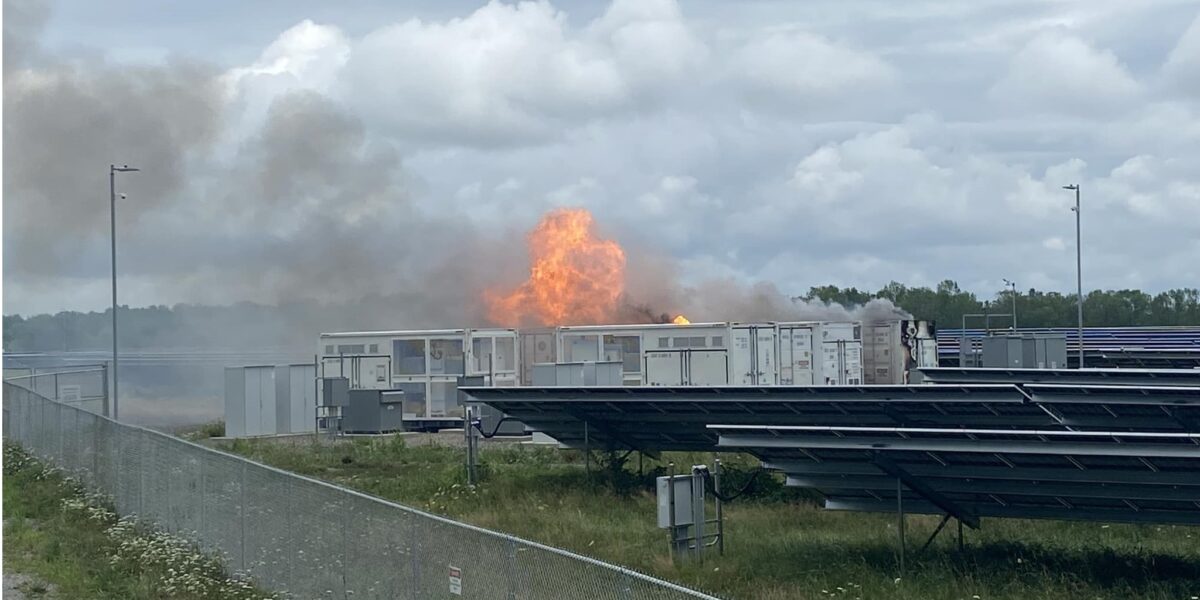Following a spate of thermal runaway incidents this summer, American Clean Power (ACP) has released its “First Responders Guide to Lithium-Ion (Li-ion) Battery Energy Storage System Incidents.”
The release coincides with New York state’s convening of an expert panel to reevaluate energy storage installation guidelines. The decision was prompted after several lithium-based battery projects faced thermal issues in New York State this summer, including the Three Mile Bay incident in the header image. And while it was not explicitly stated, the convening is presumably also influenced by the Moss Landing energy storage facility incidents.
The ACP’s guide specifically targets energy storage systems (ESS) that use Li-ion batteries, highlighting hazards like fires, explosions, arc flashes, electric shocks, and exposure to toxic chemicals. The guidance is based on the 2023 NFPA 855 revision, whose requirements apply to an ESS housed in multiple outdoor enclosures with an aggregate energy capacity surpassing 600 kWh. For systems of this scale, ACP highlighted requirements include a hazard mitigation analysis, fire and explosion testing in accordance with UL 9540A, emergency planning, and annual training sessions.
Insights from the McMicken facility’s thermal runaway and explosion in Arizona are reflected in the current code.
Pre-incident planning
Facilities with a capacity over 600 kWh must submit a comprehensive set of pre-incident documentation to both local authorities and firefighting departments. Key documents include fire and explosion test results, a hazard mitigation assessment and a detailed emergency response plan.
While the fire and explosion test results primarily focus on smaller components like battery cells, packs, and racks, the hazard mitigation report focuses on larger scale scenarios that could lead to a full-blown enclosure fire. The guide cites examples such as insulation loss leading to arcing or mechanical damages from vehicle impacts or flying debris.
Following the incident at McMicken, first responders now have mandated access to the battery management system data. During that Arizona mishap, adequate sensors and data would have alerted the first responders to the accumulating gasses in the battery enclosure. Knowing the temperatures of adjacent energy storage units can guide fire departments on any added protective measures.
Incident response
Emergencies involving fires, explosions, arc flashes, and toxic chemicals require quick assessments and appropriate protective gear upon arrival.
If there’s an active fire, allowing it to burn out thoroughly ensures the consumption of all fuel sources, reducing reignition risks. Monitoring neighboring enclosures to curb fire spread is paramount.
When there is no evident fire, the data from battery management systems proves invaluable insight into the enclosure’s internal situation and whether a thermal runaway event has occurred. During these types of events, accumulated gasses and mounting pressure within the battery unit create a volatile mix, risking explosions if unchecked.

Source: APS DNVGL
The McMicken event was triggered by gas accumulation. Responders, uninformed due to a lack of data, breached the enclosure, introducing large amounts of oxygen and driving an explosion that injured eight of them. One was thrown 73 feet from the container upon trying to access it.
Through any incident, the dangers of arc shock and toxic chemical exposure must be considered. Energy units, irrespective of the damage extent or visual status, should always be treated as fully charged. Combusted materials can release toxic gasses like hydrogen fluoride and carbon monoxide, demanding caution.
Hazard discussions
Concluding the guide, ACP sheds light on emerging industry views on incident management. Lithium-ion discussions oscillate between robust systems that curtail thermal events – risking explosions – and the “make it burn” approach:
Some ESS designs employ a ‘make it burn’ strategy, in which a sparker ignites flammable gas when the lower flammable limit is exceeded but before the lower explosive limit is reached. Such designs do not include fire suppression, on the basis that the loss of an enclosure through controlled burning is preferable to increasing the risk of an explosion.
In potential explosive scenarios, the wisdom of active venting enclosures is reiterated. If a first responder is unsure about an enclosure’s venting status, merely opening it can be useful – but perilous. Simple venting actions might not suffice in all cases, with active gas extraction deemed a more effective risk-mitigation strategy.
This content is protected by copyright and may not be reused. If you want to cooperate with us and would like to reuse some of our content, please contact: editors@pv-magazine.com.








An NFPA 18A compliant encapsulator agent is proven to render toxic and explosive gasses non-hazardous, remove thermal energy orders of magnitude more efficiently than plain water and render electrolyte non-flammable. These water additives can be a game-changer.